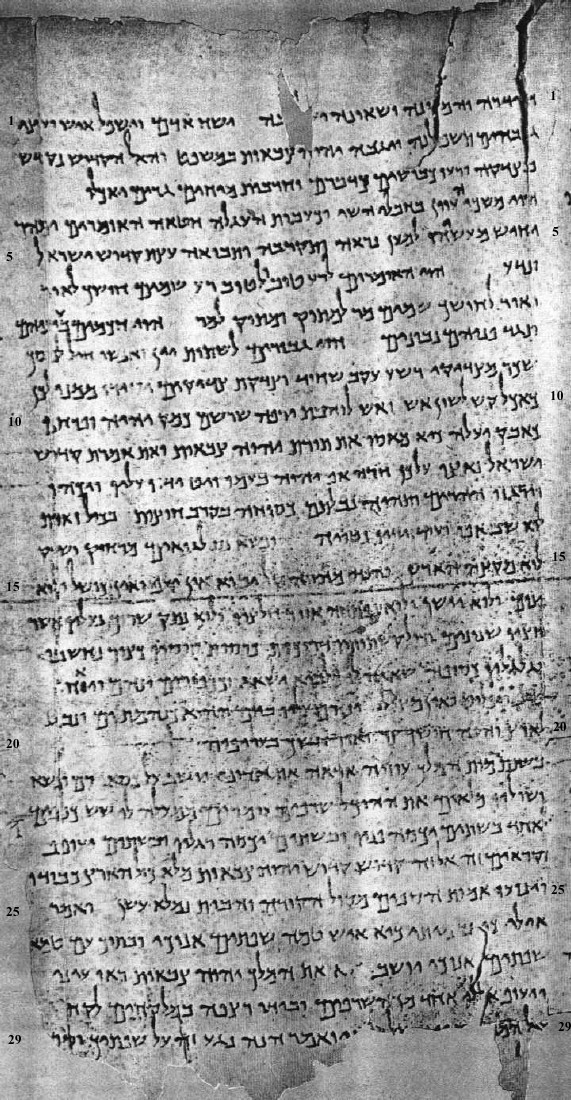
The Great Isaiah Scroll 5:14 to 6:7

Physical characteristics: This is the second page on this the second strip of leather sewn in the scroll. There will be four pages on this strip rather than the average one usually containing three pages. Some of the leather has disintegrated and there are portions of the last line missing but at least a trace of each letter is still visible. Except for a small fragment missing in mid first line which has obliterated one or two letters there are no other missing letters on this page. The two splits or tears separate words slightly but they are still readable.Spatiums: There are 7 spatiums indicating breaks in thought in lines 1, 6, 7, 8, 14, 15, and 25. These correspond to the beginnings of verses and the versification is the same as in the received text.. In line 1 the beginning of verse 5:15. The space in line 6 begins verse 20. Space in line 7 begins vs 21. In line 8 it is vs 22. The space in line 14 begins vs 26. The spatium before the last word on line 25 begins vs 6:5.
Paragraphs: The paragraph in line 3 ends verse 17 and verse 18 begins with the first word of the next line The paragraph in line 20 ends chapter 5 and the next line is the beginning of chapter 6.
Line 19: Correction: The first word in line 19 is obliterated. It is unreadable. The editor has put dots under and over this word to indicate a mistake of some kind and there is a word missing but there is no attempt to edit the mistake. The missing word should be "tereph" (prey).
Inserted letters between the lines: In line 4 the article He is written between the lines on the second word. Directly below that is a yod that was elided and a waw as a conjunction is above line 6 where it is meant to be ve-la-tov. In line 7 , the last word the ayin was left out of the word be-e'yneyhem and it is written above the word. In line 18 an aleph is written above the last word in the line which is necessary to correct the spelling.
Different readings: In verse 24 on line 10 the 5th word in Q has "ve-ae'sh" (flame) and the masoretic has "ha-shesh" (chaff). And the next word in Q adds a waw after the initial letter lamed as "lohabath" which may be fem pl ending while the Masoretic has "lehabah" (another word for flame.) But rather than the added waw being an "o" sound it is more likely that it simply represents that a vowel sound is present after the lamed. Please see the introductory page where the addition of waw for any vowel sound in Q is discussed. It is possible that Q adds only a redundant "ae'sh" and the other words ("lohabath" and "lehabah") are the same or related. In line 13 and word 3 the verb hayah is written "ve-tehayah" but in the Masoretic it is "va-tehiy". The sixth word in verse 27 "lo'" (not) in the masoretic is not found in Q. In verse 29 on line 19 just after the correction of tereph, the 3rd word is "aeyn" (not) But in Q there is a superfluous nun which begins the word.
Other Variations in Q from the Masoretic Text:
Line 1: 6th word: Q = cj waw missing which is in M.
Line 4: 5th word: Q = "ha-shav" with out final aleph (the vanity) and M = "ha-shav' " with final aleph. The pronunciation is the same.
Line 5: 1st word: Q = "yachish" imp 3ms (make haste) and M = "yachishah" imp 3ms + cohortive (Let him make haste). 5th word in line 5: Q = "ve-tiqrovah" with the addition of a final "he' not in M. The addition of "he" to the end of many words in Q nat having the "he" in M is very frequent. many times there is not apparent grammatical reason for the addition of the "he" and it is simply the Aramaic "accent" of the scribe. There are other cases where there is a real grammatical reason for the addition of the "he." This is discussed at length in the Introductory page.
Line 6: 1st word: Q = a "he" missing from the word "we know."
Line 14: 5th word: Q = "yadayv" Q adds a yod before the 3ms suf. This can be mistaken for a plural noun construct + suf. The addition of this yod before the suffix is frequent in Q and is to be considered a sign of construct rather than indicating a plural noun. See further under section VI. and subdivision D. on the Introductory Page.
Line 15: 1st and last words: Q adds aleph. "bo" is missing and would have aleph appended ordinarily (The last word is "ve-lo' ") Both words are preps. + suf 3ms and in M are simply "lo" (to him) and "bo" (in him). Aleph is added to many cjs and preps that end ordinarily with a waw or yod. See section VI. E. on the Introductory page.
Line 24: 1st word: M= "ve-qar'a " cj + verb qal per 3ms (and he called) [cried] and Q = "ve-qariym" cj + masc pl part. which may be translated "and crying" or "and they cried." 5th word: M has 3 occurrences of "qadosh" (holy!) while there are only 2 occurrences of this word in Q.